NVIDIA Shield Review: At the Crossroads of PC and Mobile Gaming
by Brian Klug on July 31, 2013 12:14 AM ESTGPU Performance - 3DMark
The GPU performance story is finally a competitive one for NVIDIA. Although Tegra 4 lacks full OpenGL ES 3.0 compliance, it does finally dedicate enough SoC die area to GPU performance to compete with the likes of Apple and the iPad with Retina Display. We'll start with 3DMark, which is Android and Windows only at this point.
3DMark for Android features the Ice Storm benchmark and uses OpenGL ES 2.0. Ice Storm is divided into two graphics tests and a physics test. The first graphics test is geometry heavy while the second test is more pixel shader intensive. The physics test, as you might guess, is CPU bound and multithreaded. The overall score takes into account both graphics and physics tests. The benchmark is rendered to an offscreen buffer at 720p/1080p and then scaled up to the native resolution of the device being tested. This is a very similar approach we've seen by game developers to avoid rendering at native resolution on some of the ultra high resolution tablets. The beauty of 3DMark's approach here is the fact that all results are comparable, regardless of a device's native resolution. The downside is we don't get a good idea of how some of the ultra high resolution tablets would behave with these workloads running at their native (> 1080p) resolutions.
Here we see Tegra 4 in Shield outperforming all of the shipping players on Android, and virtually tying with Adreno 330 in Qualcomm's upcoming MSM8974 (Snapdragon 800 platform). Tegra 4's GPU performance is still no where near even Intel's HD 4000, but we're seeing massive improvements in raw FP throughput in ultra mobile GPUs. I'm very eager to see what's possible once Kepler makes its way into NVIDIA's mobile SoCs next year with Logan.
The 3DMark Physics test is also worth looking at as it shows a 36% increase in performance over four Krait 300 cores running at 1.5GHz. There are faster Krait 300s out there, but another 13% isn't enough to make up this gap. The Krait 400 comparison is much closer, but the Krait 400s have to be clocked at 2.3GHz to equal the performance of the 1.9GHz Cortex A15s. It remains to be seen which combination is ultimately lower power.
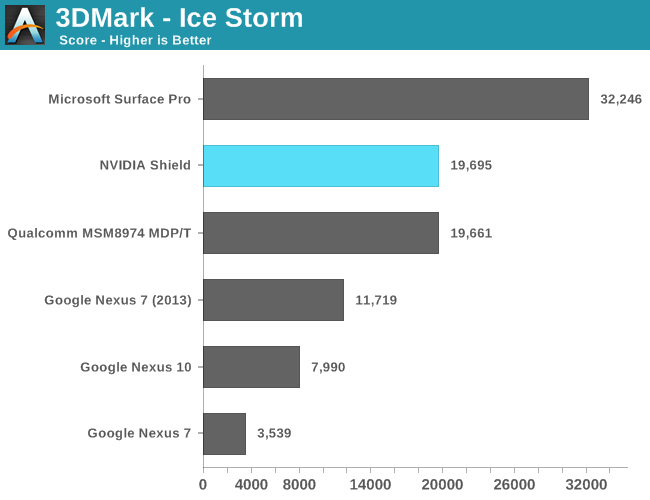

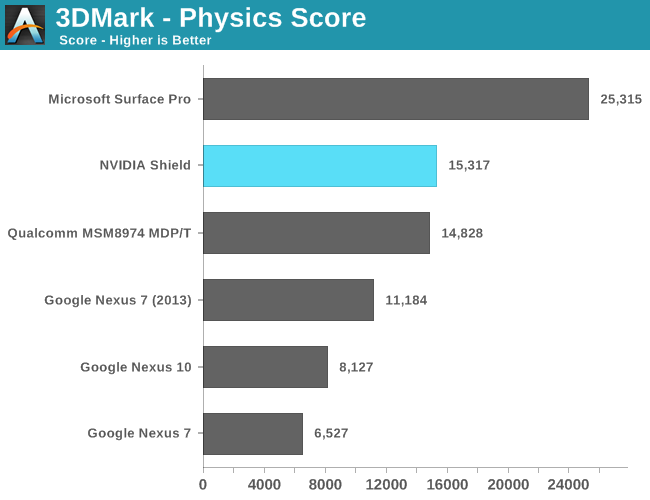
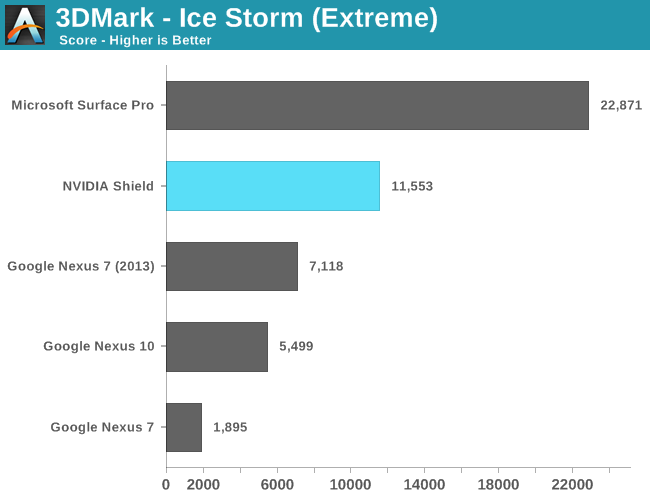
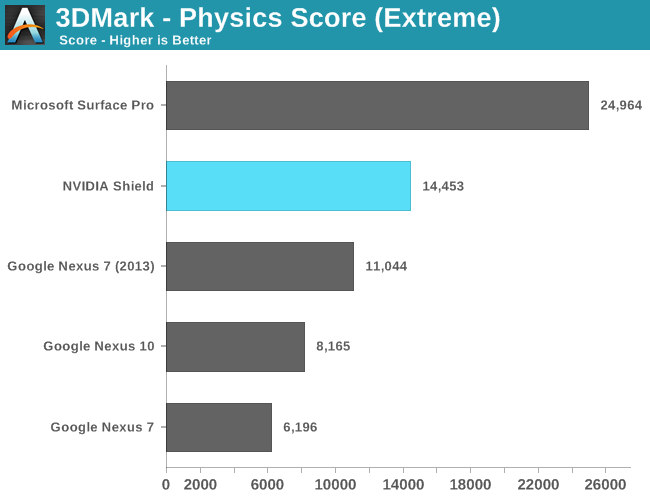

Basemark X
Basemark X is a new addition to our mobile GPU benchmark suite. There are no low level tests here, just some game simulation tests run at both onscreen (device resolution) and offscreen (1080p, no vsync) settings. The scene complexity is far closer to GLBenchmark 2.7 than the new 3DMark Ice Storm benchmark, so frame rates are pretty low.
In both tests, NVIDIA posts big gains over anything presently shipping from the Android camp. Adreno 330 pulls ahead on a level playing field, holding a 24% performance advantage over Tegra 4.
I would've loved to have seen this sort of competition from NVIDIA back when the iPad 4 launched, but it's at least good to see NVIDIA move from being a value player with Tegra 3 to a high performance contender with Tegra 4.
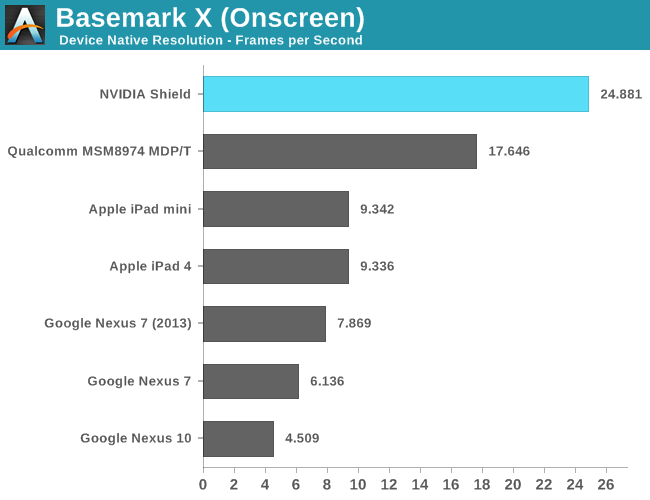











134 Comments
View All Comments
PC Perv - Thursday, August 1, 2013 - link
Sure weight balance matters.. for first 10 minutes or so. And no doubt it will be easier to hold something with evenly distributed weight than, say, something to heavy. But that doesn't mean it's absolute weight dissipate in the air because of shape. You will be holding 579g of weight no matter what. If you think 579g is "light," then I have nothing more to say. But the reviewer's bias is palpable.I'm looking forward to encountering someone holding this abominable. Hopefully he didn't buy this junk after reading this irresponsible "review." Look how this dude goes length to convince readers how this ugly is somehow "elegant."
tabascosauz - Thursday, August 1, 2013 - link
Who are you to hate on Brian?Do you seriously think that a portable game console will weigh the same as a 290g Nexus 7? It's a first step for Nvidia and it's performed well, so how did Brian write an "irresponsible review" and "convince readers how this ugly is somehow elegant"? He already said that he spent 2 hours playing BL2 and didn't feel too uncomfortable, what else do you need? Do YOU have a Nvidia Shield?
Spunjji - Thursday, August 1, 2013 - link
3DS XL: 336gPS Vita (3G): 279g
Not to defend the original poster too much, but the weight is very high for a product of this sort of category and that is indeed something that can only be properly assessed by a longer period of game-play.
Death666Angel - Thursday, August 1, 2013 - link
They are much less powerful, feature fewer and different (in my opinion, a bit inferior) controls, have much less battery life in them and are much less versatile. :) To think the Shield is a hand held console the kind Sony and Nintendo make is very misguided imho.jeffkibuule - Thursday, August 1, 2013 - link
Neither are designed to be very comfortable to hold for an extended period of time. Neither are ergonomic to your hands.PC Perv - Thursday, August 1, 2013 - link
Here is the question I pose to you: when do you think this author will realize this thing is heavy and ugly?Answer: when the next iteration of the Shield comes out. (If it does come out, lol) when the next version sport slimmer, lighter body then he will gush over how much improvement NV have made. He will THEN tell you how NV's first "attempt" was rather clunky and heavy (per "some" users). Until then he will be "oblivious" to the ugliness and monstrosity of this "Shield," and keep asserting how "elegant" and comfortable it is, blindshading potential buyers.
Of course he already knows all this. But in this type of "reviews" often there is something else is at work.
spugm1r3 - Tuesday, August 6, 2013 - link
Most people don't know how heavy or bulky something is, in particular if it is a joy to use, until the next iteration. I used to own an iBook that weighed just shy of 6lbs. It was hardly top of the line, but I loved it. Now, even Apple's most powerful portable is less than 5lbs.Other portable gaming consoles (3DS, Vita) play portable games or, at best, portable versions of console games. This plays PC games, in particular, PC games that are not exactly visual lightweights.
Honestly, some tech websites I could understand your cynicism, but Anandtech generally does a pretty good job of keeping it honest.
Subzero0000 - Thursday, August 1, 2013 - link
579g is definitely "light". There, I said it.I've been using iPad2 for almost 2 years, and I tend to feel it too"light" personally.
As for the Shield, you will hold it with two hands anyway. That weight would means nothing to a full grown man.
Spunjji - Thursday, August 1, 2013 - link
http://www.thefreedictionary.com/relative3.
You're entitled to your opinion but that doesn't make it valid for everyone else. ;)
chizow - Thursday, August 1, 2013 - link
I'm not going to argue the semantics of what you wrote, you questioned whether weight is relative to shape, in the hands, and yes of course it is. Overall the impact of total weight is relative sure, but you also seem to miss the fact people have different tolerances and preferences. Some contemporary and relevant examples today include the 360 controller vs PS3 controller and the iPhone vs. Samsung Galaxy. You will find people on both sides of the fence who prefer or abhor the different weight characteristics of each, based purely on personal preference.As for the commentary on aesthetics, you do realize that is one of the most subjective criteria out there right? That's about as subjective as people's tastes in cars, or even computer chassis. Yet in your criticism of Brian's choice of words, you do realize you come off as every bit the extremist in your own choice of words right?